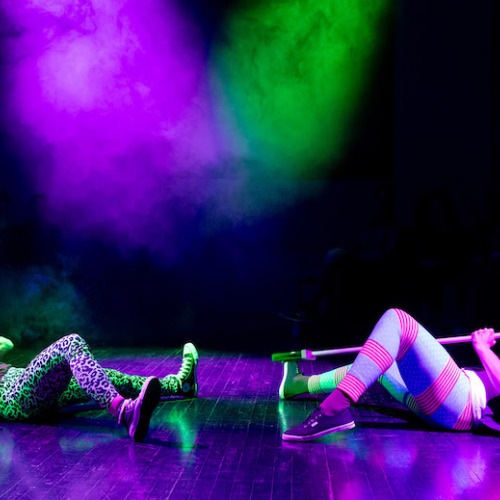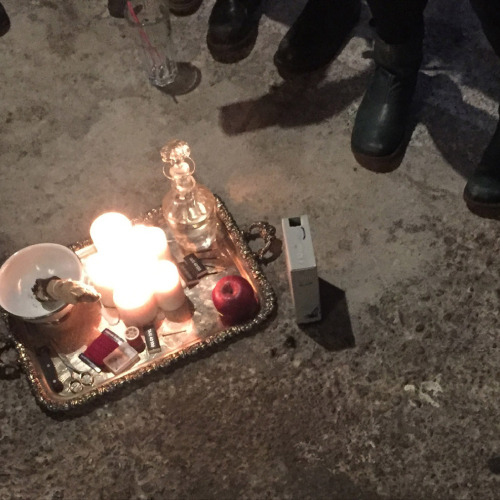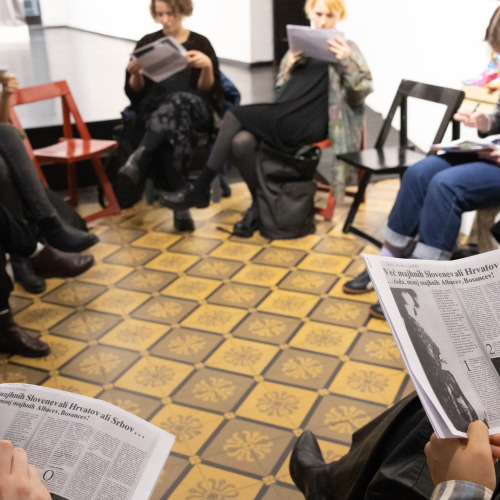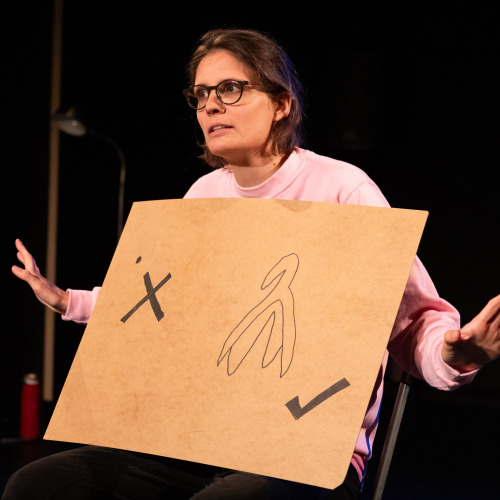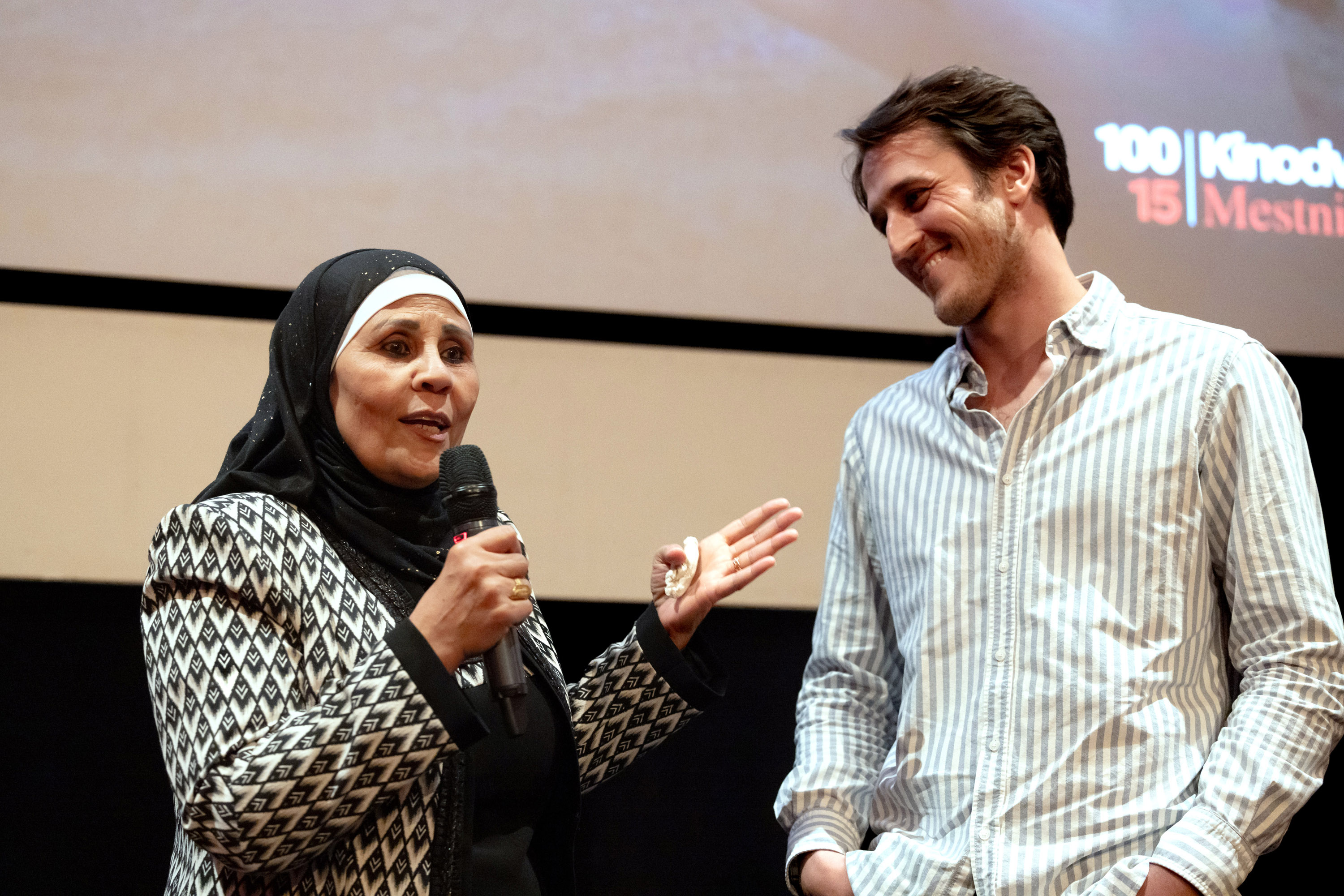
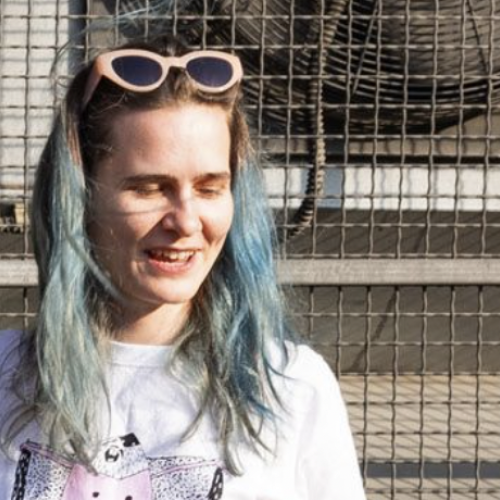
Who is Afraid of Women in Cinema?
Films are a way through which we can re-imagine.
— Yvonne Rainer
This year’s festival film programme featured several short films by female directors from Slovenia and Bosnia and Herzegovina: Newsreel Front 242 – Sunny Railways (Obzornik 242 – Sunčane pruge) by Nika Autor, Natural Selection (Prirodni odabir) by Aleta Rajič, Rooster (Pivac) by Sabrina Begović-Ćorić, When the Morning Dawns (Kad jutro svane) by Karmen Obrdalj, Piece of Freedom (Komadić slobode) by Sara Ristić and Boja by Anna Fernandez de Paco. The programme of the short films from Bosnia and Herzegovina was titled Through the Lens of Film: Women on Women. This title serves as a starting point for a brief discussion about women on and in front of the screen.
The women’s movement of the late 1960s and 1970s catalysed a critical examination of cinematic representations of women and other oppressed groups, their practices of spectatorship and participation in film production. Feminist film theory, operating on two levels – thematic-content (addressing the question, “What is the meaning of the film?”) and formal-semiotic (“How is this meaning produced?”) – posits that cinema, as a spectacular cultural form, reproduces relations of domination at the level of vision. As Teresa de Lauretis writes in her book Technologies of Gender (1987), cinema as a ‘technology of gender’ is directly involved in the production of gender subjectivities, making visible both the authoritative mechanisms that are part of gender identity production, and the manifestation of alternative sexualities and subversive subjectivities.[1] As early as the late 1970s, French feminist film theorists initiated discussions on the sexualization of the female star’s image within narrative cinema. These discussions delved into the examination of cinematic techniques, encompassing lighting, framing, and editing, alongside specific cinematic codes like the gaze system. These – and other – elements of the cinematic apparatus[2] collectively construct a woman as an image – an object for the voyeuristic gaze of the viewer. These feminist scholarly inquiries concurrently involved a comprehensive study and critique of the psycho-social, aesthetic, and philosophical discourses underlying the representation of the female body as “the primary site of sexuality and visual pleasure”. In her iconic essay “Visual Pleasure and Narrative Cinema” (1975), Laura Mulvey describes how in narrative cinema, women on screen are often reduced to the position of objects for the gaze and pleasure of the (male cis-straight) protagonist and viewer. She argues that, in Western culture, film is structured by the subconscious of patriarchal society and that the rules of a “foreign” game – receiving a male type of pleasure – have always been imposed on female spectators, for instance, the inherently voyeuristic pleasure of looking at a woman’s (naked) body. A brilliant example of this type of pleasure is a masterfully shot sex scene in the climax of the When the Morning Dawns that I will discuss in more detail later. Developing her argument based on the psychoanalytic film theory, Mulvey says that as the viewer identifies with the camera lens (the only available position since the viewers are compelled to adopt “someone else’s” gaze while watching the film), they essentially “borrow” the ideological position personified by the camera as the subject of vision. In classic Hollywood cinema, dominated by cis-male directors, cameramen, and producers, a woman invariably acted as an object of spectacle. For example, Marilyn Monroe is the embodiment of “femininity” from a man’s point of view; she is a passive object of observation, voyeuristic pleasure, a projection of male fantasy. Later on, Mulvey would challenge her own argument, asking what happens when the protagonist, the spectator, and the camera-person/director are all female.
This reminds me of Dorothy Arzner, who identified as a lesbian and was one of the very few female directors who achieved success in Hollywood from the 1920s through the 1940s. Her feature Dance, Girl, Dance (1940) is often referred to in works on women’s cinema as a kind of model of what the critique of spectacle can look like in film. In one of the film’s scenes,[3] a female performer, Judy (Maureen O’Hara), turns on stage to her mostly male audience and tells them how she sees them. This “return of the gaze”, a gesture whose subversive character has been known since the scandal around Manet’s painting Olympia, does indeed turn the convention (of object-subject relations) against itself at least in the diegetic film space. The female protagonist becomes a subject with agency, using her voice and looking directly at the audience.
Nika Autor: Newsreel Front 242 – Sunny Railways
The camera works in a similar way (and yet distinct from the visual form of a documentary) in the final sequences of Newsreel Front 242 – Sunny Railways, where we see the granddaughters of Yugoslavian youth labour actions participants, captured with medium close-ups, looking directly into the camera. The use of the medium close-up shot, framing the subject from above the head to just below the chest, allows viewers to get close enough to see the facial expressions and body language of the female protagonists, while still including the background – the context/(her)story – in the frame. When phrases from a silent narrator, stylized as regular subtitles, appear on the screen in combination with close-up shots of the female protagonists, we become their voice, interpellated into the film’s symbolic order that constructs us as collective subjects with a potential to “reconceive our better emancipatory images of life”.
The film literally inscribes the collective female subject into the landscape and history. It starts with extreme wide shots of the landscape, while the titles appearing on the screen bring us to the time and space of Tito, Yugoslavia, and labour actions. This was a time that Lejla Kalamujić describes in her book Call Me Esteban as “the time of labour actions, from which some returned with kidney inflammation”,[4] telling the story of the protagonist’s mother. It was the time of hope and the time of the future – a future that didn’t become our present. This short film constructs a historical female subject, creates HERstory (as opposed to HIStory) by editing together discovered footage from the building of the Šamac–Sarajevo railway in 1947 with the shots of landscapes, trains, train stations, and the railway of those days. The female brigadier from Palestine, whose figure we see on the discovered footage in the beginning of the film and whose story frames the narrative, doesn’t have a name and we can’t see her face. Nameless and faceless, she becomes a symbol of the transnational solidarity, reciprocal help, comradeship, and emancipation that once brought her to Yugoslavia. We can’t see her face or to hear her voice, but in the final scene of the film, we see the generations of women living on those territories after her looking directly into a future that is still possible.
When the Morning Dawns
The “return of the gaze” in the climax scene of When the Morning Dawns is of a different kind. The scene starts with a sequence of medium shots depicting the three main characters dancing in a nightclub. We can hear neither them nor any ambient sounds, only the soundtrack. The camerawork establishes the dialogue space by combining medium and close-up shots of the protagonists talking to each other while dancing and kissing. We can discern that Iskra’s boyfriend has asked her something unpleasant because of her facial expressions and body language. The intercut shows us her inner state represented by a jump cut sequence of close-up shots of her face. Iskra looks directly at the audience. As we understand from the subsequent sequence, her look is a response to her boyfriend’s proposal to engage in a threesome with an actress with whom he is having an affair. Her look reflects the power relations as we see her speechless, in tears, and disoriented. Her subjectivity, as the jump cuts suggest, has fallen apart. The position of the viewer is unified with the position of the main male protagonist, signifying a meta-position that conditions Iskra to “play her role” in satisfying male desire. This position transforms from a neutral observer (of the characters dancing) into a position of domination and control (during the threesome scene). The sex scene is captured with a high angle shot, wherein the camera is positioned above the protagonists, looking downward, creating a sense of vulnerability and revealing the power dynamics that constitute both this scene and the whole film. The last three minutes of the film show Iskra driving her bicycle into the sunrise, away from her ex-boyfriend (hopefully) and his lover Mija. The bicycle, the soundtrack, and the warm light make the scene awfully calm and hopeful, as if Iskra’s painful experience of subordination (and participation in unwanted sexual activity) had never happened.
Rooster
The short film Rooster offers another trajectory for the cinematic construction of female subjectivity. There is no graphic violence in the film, we do not actually see Milica abused by her husband, even though domestic violence is the context of her story. Her story is about an attempt to overcome victimisation and to speak for herself, to gain agency. Most of the film time is dedicated to a scene at the police station, where Milica is trying to explain to an impatient police officer that she cannot testify against her husband, and needs protection and intervention by an authority figure. For the police officer, Milica is yet another client, another victim of domestic violence, someone who should obey the rules to be recognized as a subject. In a short scene of a dialogue between the police officer and his female colleague, whom he is trying to date, we can see a miniature representation of the power relations that constitute gender and frame the experience of being a woman in patriarchal societies. The scene is filmed in one shot and we can see both police officers from Milica’s point of view as a reflection on a glass surface. The male police officer gives a present to his female colleague and grabs her elbow while asking her to go out with him. She refuses and he tries to insist, but she firmly says “no”, frees her hand and … smiles back at him. This scene shows a woman in a position of power, nominally equal to her male colleague, as still conditioned to be an object of desire and using her own oppression as a resource in the power struggle.
Similarly to the main female protagonist of When the Morning Dawns, Milica revolts at the very end of the film. Together with the scriptwriter of the film, Melina Alagić, she refuses to obey the stereotypical narrative structures that reproduce systems of patriarchal oppression by denying alternatives to them. Milica goes back home. But this time, she isn’t trying to be polite to the female neighbours (the guardians of societal norms, as common sense and the shot’s composition suggest), waiting for her in the village, but sends them to hell. Almost at the threshold of her house, she hesitates, changes her mind, and leaves. We don’t see her face, as the final scene is captured with a full shot, but because of this possibility to concentrate on the mise-en-scène, we can believe that Milica leaves not only her husband, but also the social relations that brought her to a subordinated position.
At the discussion after the film screening in Slovenska kinoteka, Melina Alagić said that despite the end of the original story Pivac by Tanja Mravak, which became the basis for the film script, she couldn’t leave even the slightest possibility of Milica going back to her abuser. This narrative decision, which questions the patriarchal status quo, is definitely a sign of a shift in the societal understanding of gender relations and diversifying normative film representations of women and female experience in the region.
Why women’s cinema?
In women’s cinema there is a clear desire to produce a new, alternative, non-colonized vision of activities and roles traditionally delegated to women and marked as “female”. In this way, women’s cinema creates its own iconography of female representations (different from that presented on television, in advertising, and mass cinema). Women’s cinema solves two pressing problems that correspond to the spirit of the feminist program developed in the 1970s: the creation of a “modern” history of women’s art and alternative representations of women. This is why I found it surprising to hear at the talk with the filmmakers from Bosnia and Herzegovina that the categories “women’s film” and “female director” are not seen as part of the re-vision of the position that women were conditioned to since the first years of cinema. Obviously, this caution can be prompted by various factors. As Alison Butler argues in her book, “some of the most distinguished practitioners of women’s cinema have deliberately distanced themselves from the notion, for professional and/or political reasons, to avoid marginalisation or ideological controversy – e.g., Larissa Shepitko, a great Soviet director, who considered women’s film inegalitarian, or female directors from Iran, for whom such identification could cause political pressure and prosecution.[5] But quite often this denial is caused by thinking about art as a universal human sphere for the free self-realisation of individuals that allows production of universally relatable cultural forms and content. As Linda Nochlin wrote in her article “Why Have There Been No Great Women Artists?” (1971), it would be a big mistake to consider (as many do) art as “a free autonomous activity of a gifted individual”, whose activities are influenced only by previous artistic tradition. Art always takes place in a certain social situation; it is rooted in the social structure and mediated by the activities of certain mostly patriarchal social institutions – art academies, educational institutions, and the art market.
To come back to the title of this article, the discomfort that categories such as “women’s”, “feminist”, and “queer cinema” bring to some filmmakers, film critics, and members of the audience, is understandable. By merely existing, these categories challenge the myth of a divine (male) creator and the understanding of art as the universal and apolitical practice of unconditional creation and freedom that lies beyond power struggles and subordination.
Inherent to feminist and women’s film thinking about oneself in other categories, the search for other meanings and other forms are threatening to the dominant cultural production that serves to re-produce the patriarchal status quo. The wish to make “good films” instead of “women’s” or “queer films” shows how deeply misogynistic and cis-heterocentrists Western culture is. The rejection of the feminist agenda (or an even less politically charged “women’s agenda”) in our societies is often based on the idea of feminism as a theory that emphasises and deepens the differences between gendered subjects. But “difference” does not necessarily mean confrontation. ‘Différance’ – as Derrida conveyed it – is a concept that opens the way to the study of variances within oneself: this is why feminism is Eastern, Western, black, white, homo, trans, queer, heterosexual … and cinema can be feminist, women’s, black, indigenous, queer, etc. It is the concept that opens us up to an understanding of difference as a positive condition of existence and presupposes the need for dialogue.[6] Patriarchal ideology is present in films on different levels, despite the will of film authors. As film lovers, film makers, and film viewers we should therefore ask ourselves, rephrasing a famous saying by Audre Lorde,[7] how we can use “the master’s (cinematic) tools” to re-imagine social order and to construct a more just world for all of us, as Newsreel Front 242 – Sunny Railways suggests.
[1] De Lauretis, Teresa. 1987. Technologies of Gender: Essays on Theory, Film and Fiction. Bloomington: Indiana University Press.
[2] For more details see Jean-Louis Baudry’s “Ideological Effects of the Basic Cinematographic Apparatus”.
[3] https://youtu.be/DIJlyz7aPr0?feature=shared
[4] Kalamujić, Lejla. 2018. Kličite me Esteban in druge zgodbe. Ljubljana: ŠKUC.
[5] Butler, Alison. 2002. Women’s Cinema: The Contested Screen. London: Wallflower.
[6] Ousmanova, Almira. 1999. “Politicheskaya estetika ‘zhenskogo kino’ v kontekste feministskoi kinoteorii [The political aesthetics of women’s cinema in the context of feminist film theory].” Gendernye issledovaniya. Vol. 3/1999. Kharkiv: Kharkivskiy tsenter gendernyh issledovaniy. PP. 225 – 235.
[7] “For the master’s tools will never dismantle the master’s house.”

